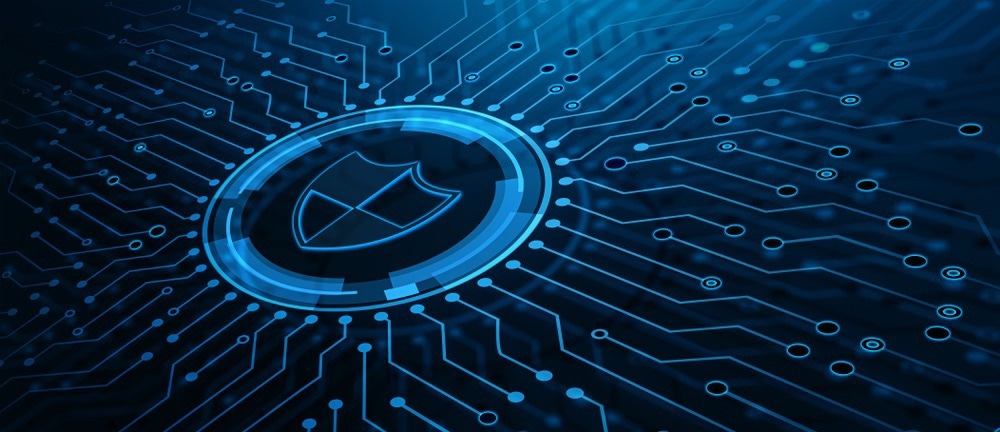Cyber security is one of the 21st century’s critical issues. In this article, AZoRobotics explores the growing use of artificial intelligence (AI) to improve threat response in cyber security.

Image Credit: Alexander Supertramp/Shutterstock.com
Artificial Intelligence in Cyber Security: A History
Nearly every sector of society and industry is connected to the Internet. Therefore, protecting data is essential. The growing use of artificial intelligence in cyber security is improving the ability of analysts and companies to respond to increased daily threats from hackers.
Emerging AI technologies such as natural language processing and machine learning help to break through the “clutter” of daily alerts, learning from previous resources to identify critical breach data and aiding analysts. This helps to drastically reduce response times and stop attacks.
Deploying artificial intelligence in cyber security helps automate the process by consuming billions of data points, analyzing relationships, and eliminating time-consuming tasks. Analysts can respond better to perceived threats, leveraging the powerful potential that increased artificial intelligence in cyber security brings.
Using artificial intelligence in cyber security also provides benefits such as cost-effectiveness, better decision-making, and removing human error. However, organizations must be aware that hackers are constantly evolving their methods to avoid detection and resist new AI-based cyber security tools.
Artificial intelligence in cyber security has seen exponential growth over recent decades as the industry evolves to meet new and sophisticated threats. It can be said that the increasing deployment of technologies such as artificial intelligence in cyber security is a new frontier in IT.
Artificial Intelligence in Cyber Security: Darktrace
Darktrace, a cyber security company based in the UK, has developed a comprehensive ‘Cyber AI platform.’ Developed over the past decade, the platform consists of two flagship products, Enterprise Immune System and Antigena. The system uses four data analysis models.
Threats are detected by understanding a company’s DNA at a granular level in the Enterprise Immune System. Higher-level threat processing tasks are fully automated by a Cyber AI analyst. Antigena is an autonomous response system that defends against machine-speed attacks, taking surgical action to protect customers.
Darktrace’s commercial AI cyber security platform utilizes data analysis models such as email, IoT, and cloud/SaaS models. Virtual and on-premises networks are also included in the system. Able to be fully integrated into existing network infrastructure, the system also includes executive reporting and mobile app functionality.
Darktrace is leveraging the benefits of artificial intelligence in cyber security to improve the network security of customers and respond to new threats by bad faith actors. By increasingly employing technologies such as artificial intelligence in cyber security, companies like Darktrace can save customers vast sums of money.
Artificial Intelligence in Cyber Security: Zscaler
Generative AI has seen particular attention in recent months as a powerful tool that can generate images, text, and other media based on text prompts. Now, Zscaler has announced AI cyber security solutions to leverage this technology.
ZScaler’s solution combines proxy-based architecture and cloud security with a large language model, analyzing a company’s security while delivering anonymized training data.
Offering a good example of how artificial intelligence in cyber security is evolving to leverage new technologies and tools, the technology minimizes potential data leakage and organizations can record and retain their content, vastly improving audits and security.
Artificial Intelligence in Cyber Security: QRadar SIEM
QRadar SIEM is one of IBM’s flagship solutions which uses the benefits of artificial intelligence in cyber security, also utilizing user behavior analytics. Built-in threat intelligence and case management improve the quality of alerts, breaking through false positives.
Near-real-time threat detection, increased productivity, and simplified management and deployment are three of the main benefits of QRadar SIEM. A 60% security breach risk reduction has been reported by IBM by utilizing the power of artificial intelligence in cyber security.
Artificial Intelligence in Cyber Security: The Future
The growth of artificial intelligence in cyber security to improve threat detection and stop data breaches is a hot-button topic in the world of IT, with the use of artificial intelligence in cyber security continuing to evolve.
The future of artificial intelligence in cyber security is one of technological innovation, both for cyber security professionals and hackers attempting to circumvent security protocols. Emerging technologies such as machine learning and generative AI are providing huge opportunities for cyber security professionals.
A growing number of IoT-connected devices, which typically have minimal security protocols, increases the number of network vulnerabilities. As the industry increasingly makes use of Industry 4.0 technologies, the benefits of artificial intelligence in cyber security are becoming increasingly obvious to industry professionals.
References and Further Reading
Menafn (2023). Zscaler Introduces New Cyber Solutions To Leverage Generative AI [online] menafn.com. Available at: https://menafn.com/1106435355/Zscaler-Introduces-New-Cyber-Solutions-To-Leverage-Generative-AI
Darktrace (2019). Darktrace Launches Enterprise Immune System Version 4 [online] darktrace.com. Available at: https://darktrace.com/news/darktrace-launches-enterprise-immune-system-version-4
IBM (2023). AI cybersecurity solutions [online] ibm.com. Available at: https://www.ibm.com/security/artificial-intelligence
Disclaimer: The views expressed here are those of the author expressed in their private capacity and do not necessarily represent the views of AZoM.com Limited T/A AZoNetwork the owner and operator of this website. This disclaimer forms part of the Terms and conditions of use of this website.